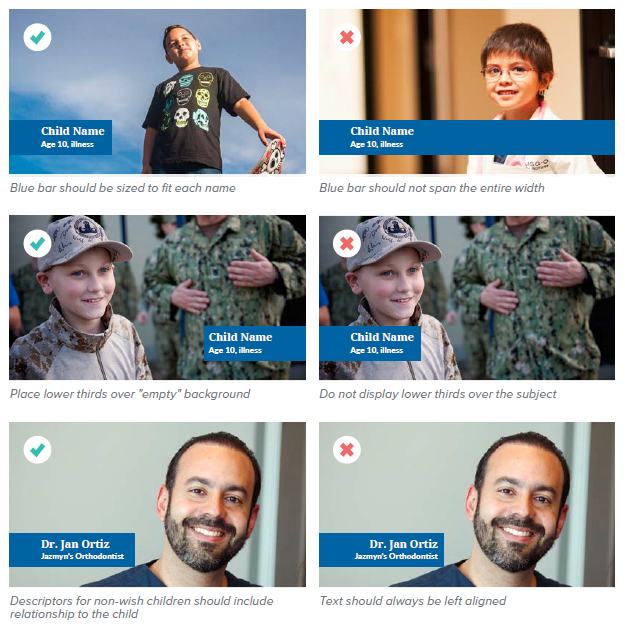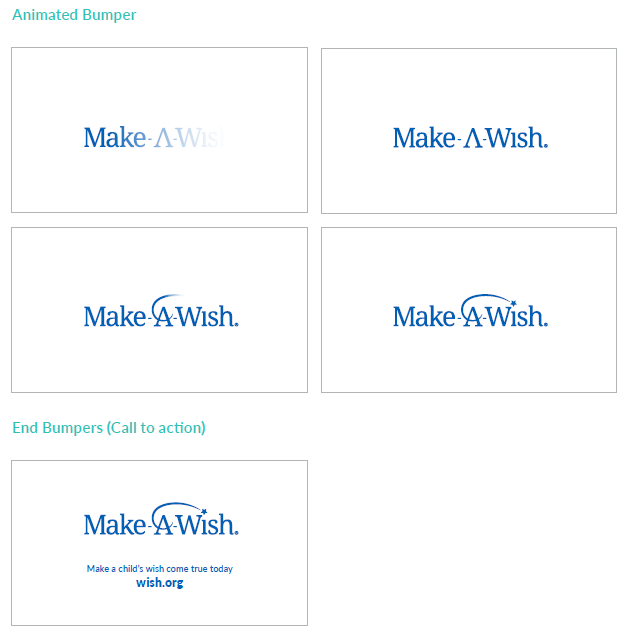Video
There is no doubt, video is becoming a dominant communications medium in our culture. The prominence and accessibility of video have made it easier for consumers to engage in an organization’s content, offerings and call to action. In addition, Make-A-Wish utilizes video because we believe it has the ability to shift perspective.
In this Section:
OUR APPROACH
From the beginning, with Chris Greicius’ wish, to Batkid's worldwide wish experience, we have been an organization of storytelling. Video provides us an opportunity to tell stories – from multiple perspectives – in an efficient, engaging and emotive way. In fact, videos allow us to show the wish journey in a way that includes the complexity of a family’s struggle with illness and the transformation that emerges from it.
Back to the top of the page ↑
BEST VIDEO PRACTICES
We encourage the continued engagement of professional videographers to help capture the entire wish journey. However, we know that the Make-A-Wish team often is placed in the role of director, producer or even videographer. The following are recommendations that help us tell the best stories we can, regardless of who films them.
Production Suggestions
Develop a plan of action.
We recommend engaging a professional video team whenever possible. Discuss an appropriate plan of action with the team before any shoot occurs. Establish appropriate roles and communicate expectations of the crew.
Respect the relationship.
Most video shoots are more grueling and longer than one would expect. All crew members, whether Make-A-Wish staff or otherwise, must put the child and their family first during any production. This means that we help create a comfortable environment, address any concerns in a friendly manner, and always ask permission for engaging in any sensitive or personal matters.
Create an inviting environment.
When engaging in an interview with a child, friend or family member, keep the environment to a minimal amount of people in order to minimize distractions or possible intimidation.
Invite narrative over commentary.
When conducting an interview, ask questions that welcome descriptive narrative responses. For example, leading with a question like “Can you describe the moment (be specific and detailed) that you met Selena Gomez?” will paint a picture for the audience that will welcome a shared experience. Commentary driven questions such as “What did you think of the experience?” often result in flat, short responses that will ultimately be forgettable.
Capture beautiful, crisp, and well lit video.
It is important that our videos reflect the Make-A-Wish brand commitment to honor the child, which includes portraying our subjects in a beautiful manner while maintaining high-quality standards of production. Ensure our subjects are in focus, utilizing a shallow depth of field when appropriate. Be conscious of poorly lit subjects or scenes and compensate with professional lighting as needed.
Capture appropriate b-roll.
When supporting a narrative-driven video, capture plenty of good b-roll (extra footage to help enhance the story). If you have the luxury of capturing b-roll after an interview or a narrative is established, seek out b-roll that can support this. Some b-roll should cover people other than the child as the hero.
Capture high-quality audio.
Audio is as important as the visual capture in any video production. Avoid environments with sporadic background noises and utilize audio equipment that records high-quality audio.
Back to the top of the page ↑
TECHNICAL RECOMMENDATIONS
Recording/capture
Resolution
Record in 1920 × 1080p whenever possible
2160p (4K) resolutions are also acceptable
Frame rate
Record in 23.98p whenever possible
Frame rates of 29.97p and 30p are also acceptable (when necessary)
Audio encoding/export
Bit rate
| Stereo | 320 kbps |
|---|
Video encoding/export
File type (container)
MPEG-4 (.mp4)
Codec
H.264
- Progressive scan (no interlacing)
- High Profile
- 2 consecutive B frames
- Closed GOP. GOP of half the frame rate
- CABAC
- Variable bitrate
- Chroma subsampling: 4:2:0
Frame rate
Content should be encoded in the same frame rate it was recorded
Frame size
| Maximum | 1920 x 1080 |
|---|---|
| Minimum | 720 x 1280 |
Bitrate
| 1080p | 10 Mbps - 15 Mbps |
|---|---|
| 720p | 6.5 Mbps - 9.5 Mbps |
Aspect ratio
16:9
Back to the top of the page ↑
LOWER THIRDS
Lower thirds, the descriptor for the subject in a video, can be displayed on either the left or right side of the subject, but must appear 200px from the side and 720px from the top of the frame. They should not interfere with the subject, and be sized to each name (side margin opposite the base along the edge of the frame should be equal to the top and bottom margins of the text inside the blue bar).
All lower thirds for children should have the name set in 70pt Droid Serif Bold type. Descriptor lines should be set in 54pt Lato Bold type with 76pt leading, and should include the child's age and illness. For adults, the descriptor should only be the person's title and/or relationship to the child. Additionally, text should always be left aligned.
Subtitle guidance: use Arial font in white or black. Ensure lower thirds are not covered by subtitles.
Back to the top of the page ↑
ANIMATED VIDEO BUMPERS
To bookend a Make-A-Wish video, intro and end “bumpers” should be used to create a consistent series. Intro bumpers should have the full-color logo animate on over a white background – the text should fade on from left to right, and then having the swirl appear from the bottom to the top, ending with the star dotting the “i.”
End bumpers should feature the logo above a blue call to action statement.
Call to action: Lato Regular, 60pt/72pt.
Website: Lato Black, 80pt/96pt.
Note: Source files will be provided by the National Office.
Back to the top of the page ↑
THE BEST MAKE-A-WISH VIDEOS...
- Tell the story of the wish journey from different perspectives.
- Spark imagination and convey strength.
- Capture the positive emotions of a wish experience.
- Capture a wish participant immersed in the action of a wish and/or the impact of the experience.
- Take into consideration the environment (i.e. uncluttered).
- Capture the subject in crisp focus (utilizing a shallow depth of field when appropriate).
- Are properly lit and well framed.
- Are concise and engaging throughout – avoiding long, uncut commentary.
- Utilize music in a way that establishes the appropriate mood and offers balance.
- Avoid copyright infringement by obtaining a license or other grant of permission from the rights holder before utilizing music in a video.
- Follow brand standards when utilizing any graphics or animation.
- Are captured by a professional or experienced videographer.
- Follow the appropriate technical recommendations (as stated on page 79).
- Are accompanied by requisite publicity releases.
Back to the top of the page ↑
SHOOTING WITH A MOBILE DEVICE
The following are best practices for when a professional photographer/videographer are not available and/or additional phone imagery is captured.
Minimize shake
Due to the (light) weight of a phone, it is easy to shoot video or photos with significant shake. We recommend stabilizing the phone by supporting it with a solid surface or tripod, or by using two hands.
Be conscious of available light
Utilize available daylight whenever possible and supplement additional lighting sources as needed. Please note that shooting video on a phone typically requires more light than when capturing a still image. This tends to become more obvious when shooting inside or at dusk. We recommend simply being aware of this when engaging with mobile video.
Avoid zooming in
Zooming in on a photo or video will compromise the quality of the image and/or produce a grainy picture. We recommend leaving the phone in its native state while shooting.
Be conscious of composition
The native lens a phone utilizes is typically considered wider than what may be available with professional cameras or lenses. Because of this (and our recommendation NOT to utilize the zoom feature), there will be a need for the photographer/videographer to move closer to the subject in order to maximize the composition and increase detail. We recommend moving as close to the subject as appropriate and as needed without distraction.
Shoot horizontal
Although we often utilize our phones in the vertical format, it is important to capture video footage in the horizontal format (16:9) as this will be the format in which the videos will be experienced. Photos can be captured in vertical format when the subject or scene calls for it, but this will most likely be in a limited state.
Back to the top of the page ↑




